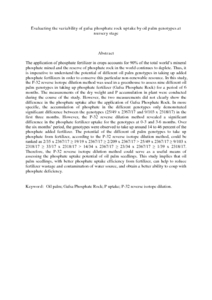Citation
Tan, N. P. and Abdul Rahman, Zaharah and Abdullah, Siti Nor Akma and Nasir, Jamaluddin
(2010)
Evaluating the variability of gafsa phosphate rock uptake by oil palm genotypes at nursery stage.
Pertanika Journal of Tropical Agricultural Science, 33 (2).
pp. 223-231.
ISSN 1511-3701
Abstract
The application of phosphate fertilizer in crops accounts for 90% of the total world’s mineral phosphate mined and the reserve of phosphate rock in the world continues to deplete. Thus, it is imperative to understand the potential of different oil palm genotypes in taking up added phosphate fertilizers in order to conserve this particular non-renewable resource. In this study, the P-32 reverse isotope dilution method was used in a greenhouse to assess nine different oil palm genotypes in taking up phosphate fertilizer (Gafsa Phosphate Rock) for a period of 6 months. The measurements of the dry weight and P accumulation in plant were conducted during the course of the study. However, the two measurements did not clearly show the difference in the phosphate uptake after the application of Gafsa Phosphate Rock. In more specific, the accumulation of phosphate in the different genotypes only demonstrated significant difference between the genotypes (25/49 x 2367/17 and 9/103 x 2318/17) in the first three months. However, the P-32 reverse dilution method revealed a significant difference in the phosphate fertilizer uptake for the genotypes at 0-3 and 3-6 months. Over the six months’ period, the genotypes were observed to take up around 14 to 46 percent of the phosphate added fertilizer. The potential of the different oil palm genotypes to take up phosphate from fertilizer, according to the P-32 reverse isotope dilution method, could be ranked as 2/35 x 2367/17 ≥ 19/19 x 2367/17 ≥ 2/209 x 2367/17 > 25/49 x 2367/17 ≥ 9/103 x 2318/17 ≥ 33/17 x 2318/17 > 14/34 x 2367/17 ≥ 23/34 x 2367/17 ≥ 1/39 x 2318/17. Therefore, the P-32 reverse isotope dilution method could serve as a useful means of assessing the phosphate uptake potential of oil palm seedlings. This study implies that oil palm seedlings, with better phosphate uptake efficiency from fertilizer, can help to reduce fertilizer wastage and contamination of water source, and obtain a better ability to coup with phosphate deficiency.
Download File
![[img]](http://psasir.upm.edu.my/14587/1.hassmallThumbnailVersion/Evaluating%20the%20variability%20of%20gafsa%20phosphate%20rock%20uptake%20by%20oil%20palm%20genotypes%20at%20nursery%20stage.pdf)  Preview |
|
PDF (Abstract)
Evaluating the variability of gafsa phosphate rock uptake by oil palm genotypes at nursery stage.pdf
Download (150kB)
| Preview
|
|
Additional Metadata
Actions (login required)
 |
View Item |

